Where to write hashtags on Instagram. Rules for using hashtags on Instagram
In order to correctly place hashtags or hashtags (you can do both) in social network Instagram, you need to understand exactly what they are. And based on the principles of their work, it is correct to place them inside the post. Without comprehensive knowledge, you will not be able to use it to your advantage to the fullest and, for example,.
What is a hashtag on Instagram
IN in a general sense it means a tag word. It is by these tags that your posts are grouped on social networks, and thanks to them, users can find articles that interest them through search. As for Instagram, here, with the help of such tags, people search for events or objects that interest them in photographs. By posting this or that photo, you can place signs for potential visitors, by which they will search for you.
Sometimes hashtags help you find people with similar hobbies. Thanks to these tags, you can gather like-minded people and develop with them. While traveling, you will have the opportunity to get acquainted with the most attractive attractions for tourists, find out where they cook well and much more useful things.
Recent trends indicate that hashtags are being used inappropriately. Nowadays, in searches you can often find spammed photos with fictitious tags, which are used to promote your account and gain subscribers and likes. This leads to the fact that search simply dies as an effective tool.
Most regional requests are already slipping into pure commerce. By entering the name of the city, you can find heaps of different shops and other advertising, but there are practically no photographs of the region or city itself. The commercial use of Instagram search is gradually destroying it completely.
As for the use of personal space inside Instagram, thanks to hashtags, you can break it down into different topics. Use different tags and sort your photos the way you want. In addition, your unique hashtags also help you to be found among a huge variety of images.
How to add hashtags to photos on Instagram
This is an easy to use tool. In the description, put the “#” symbol in front of the word, and it will turn into a label, clicking on which will lead to opening a search by this tag. Correct placement of hashtags is extremely important to attract a potential audience and develop your account.
Correct hashtags on Instagram
- Hashtags can be set directly inside the description text, highlighting some of the words. It is possible to place them on a separate line, with a space at the end of the text or in comments.
- Tags can contain any characters of the Russian or English alphabet, as well as numbers and special characters.
- Capital letters are considered the same as lowercase letters in Instagram search; you won’t be able to stand out with them.
- Differences in hashtags even by one letter result in images ending up in different .
- A space separates different tags, so if you want to make a tag of several words, you will have to separate them in something other than spaces. Hyphen, in capital letters and similar methods.
- Instagram remembers all the tags you entered and the next time you enter the “#” symbol, it will give you a list of everything you could want. Use options like these to make your work easier and faster.
You cannot add more than thirty hashtags to one publication. If you decide to use more, they simply won't count. You should be careful when choosing keywords. No need to spam. Don't try to add tags that have nothing to do with the image. Everything should be in moderation and tags are no exception in this regard.

Search by hashtag on Instagram
IN currently Instagram search allows you to search within four categories:
- Tags;
- Places;
- The best;
- People.
By choosing one of four categories, you can more precisely customize your search parameters, which allows you to quickly find what you want.
The most popular hashtags on Instagram for likes and subscribers
Hashtags are auxiliary tool, which helps in the search. You should not pay excessive attention to him and pin your hopes on him. Labels need to be set for people, which means they need to be selected accordingly. If you post, then users will be drawn to you and tags will help them with this. Do not try to use tags alone on a mediocre account; these are very dubious manipulations that do not bring real results.
Attempts to cram into every publication maximum amount tags usually leads to the fact that the search engine begins to consider you as a spammer and lowers you in the results. And you obviously wouldn’t want that. Therefore, it is worth paying attention to some features of search on Instagram:
- Popular tags have a very short lifespan. You only have a few minutes to get clicks on them. And in an hour, it will be simply impossible to find your photo, according to these words.
- Overspamming hashtags makes it difficult for your followers to perceive information. This results in less interest in the content you post.
- Overspam with tags also leads to the fact that your unique tags may simply not be noticed in the general mass and they will become useless.
Modern trends suggest only one thing: make your account for people. It should be interesting and discreet, this is how you can increase the number of subscribers and likes.
Are you ready for the sales season? We hope so, because, for example, in the US, according to eMarketer, sales could grow by as much as 16.6 percent due to pre-New Year discounts (and 3/5 of these purchases will be made using smartphones). Since a lot of money is at stake, it is simply necessary to prepare.
To help you out, we've pulled out some data from the same period in 2016, as it's one of the most effective ways prepare for the sales season. Overall, we looked at 95 million installs across 130 shopping apps, with nearly 22 million purchases. domestic purchases for a total of $450 million.
We have data on:
- Attracting users
- Buying activity
- Average revenue per purchase
- Share of users who made purchases
So let's move on to the details:
1. Inorganic app installs and in-app purchases
What does this Android graph tell us?
The peak week of the fourth quarter is the November sales. During the weeks of Black Friday and Cyber Monday, we found a 46% increase in purchasing activity compared to October (looking at domestic purchases) and 19% higher than in December (if you are interested in a breakdown by specific days, see the graph above)
Clearly, marketers decided to scale up their campaigns before Halloween and continued through the week of Christmas. Overall, if we compare install activity before Halloween and after (before Christmas week), in the latter period it is 18% higher.
Also pay attention to installs after Christmas: just imagine how many users install new applications on new smartphones, purchased or received as gifts. In fact, the first weeks of January saw 31% more installs, even compared to the best-performing weeks of November (Black Friday and Cyber Monday).
New Year's holidays also saw a peak in purchasing activity in the first week of January - results were almost as high as on Cyber Monday (only 3% lower).
Let's now look at iOS:
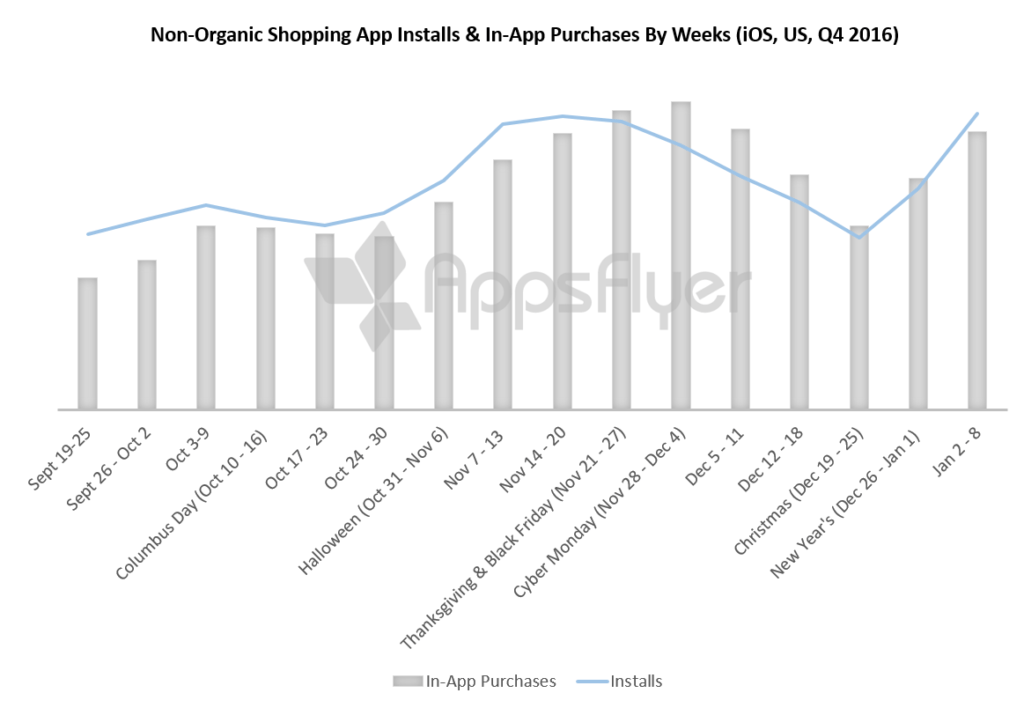
The growth in shopping activity peaks on Cyber Monday, so much so that in these November weeks of purchases there are 70% more than in October as a whole, and 31% more than in December.
User acquisition activity increases significantly in the 2 weeks leading up to Black Friday, up 44% from previous weeks in the fourth quarter.
We may also see a surge in installs after Christmas (thanks to those new smartphones bought as gifts). The first week of January shows installation results 33% higher than the period before Black Friday.
Buying activity increases before Christmas, and during the New Year season sales increase by 26% compared to Christmas week and by 30% compared to October.
2. Peak period of installations and internal purchases – compared by day
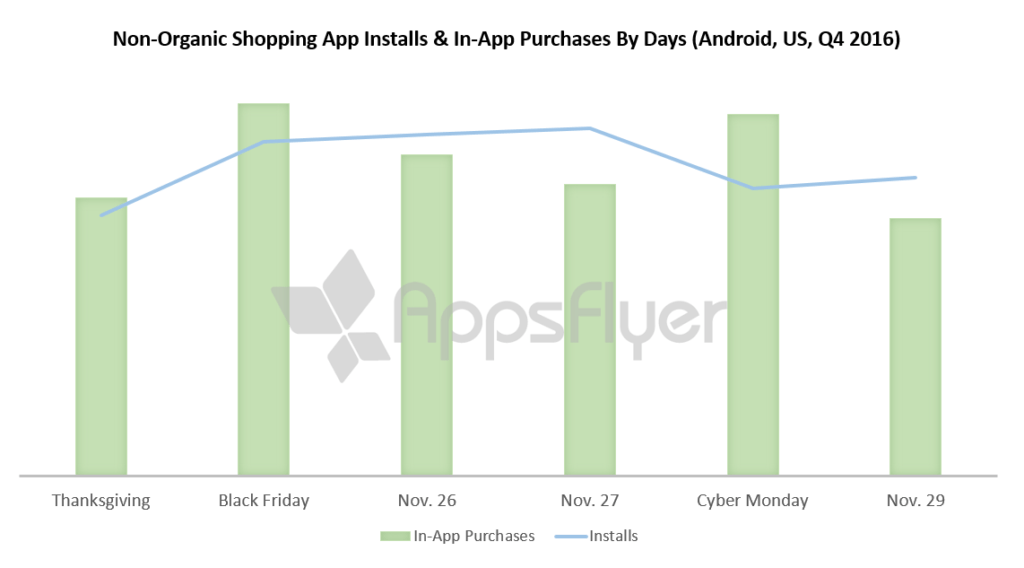
If you look at the number of installs by day, you will notice that there were 3% more purchases on Black Friday and 16% more installs than on Cyber Monday. You can compare it with Thanksgiving, which showed no results at all.

On iOS, we see a breakthrough on Cyber Monday in terms of purchases (9% higher than on Black Friday), but “Friday” shows the result in installs 12% higher. Thanksgiving doesn't get any better than on Android.
3. Organic installs during the fourth quarter
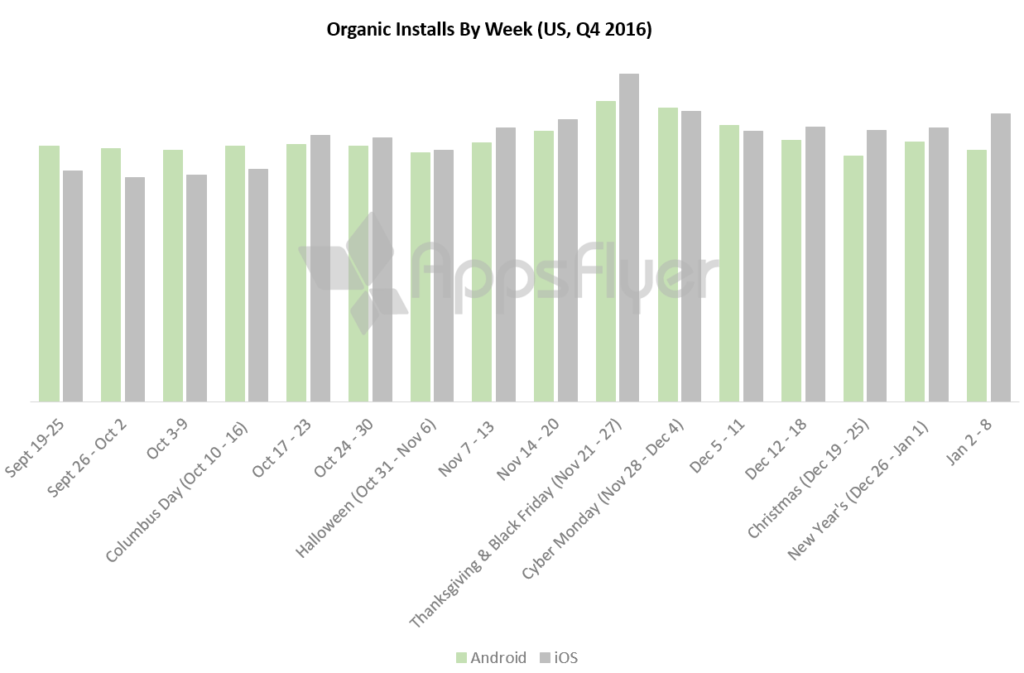
The result for organic installations is not surprising. The only interesting thing is that in the peak week before Black Friday, shopping apps were installed more often than the average for the fourth quarter, by 25% on iOS and 16% on Android.
4. Average profit per purchase
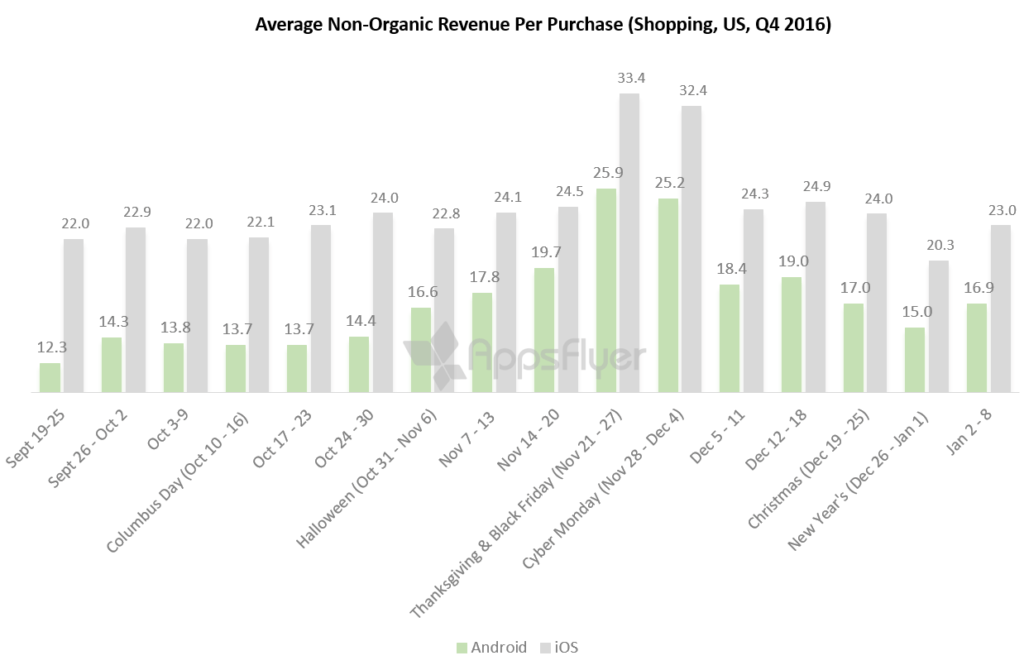
As for profit, here iOS is ahead of Android in terms of the average purchase size of $24.3, which is 41% higher than Android’s $17.3.
The end of November showed an increase not only in the volume of purchasing activity, but also in the amount of money spent (iOS users spent 58, and Android users- up 66 percent from other weeks in the fourth quarter).
Also we can see that the cart iOS users remained relatively flat throughout the period (including the weeks of Black Friday and Cyber Monday), while average spending on Android ranged from low spending at the start of Q4 (46% lower than November) to a peak in December, before Christmas.
5. Share of users willing to pay
We wanted to test the relationship between the period in which users were acquired and their attributes, in particular whether their purchasing activity was dependent on their acquisition time. Therefore, we focused on 5 cohorts of users: users of the first half of July, the first half of November, the peak period - the second half of November, Black Friday and Cyber Monday and the first half of January.
The July group is given as neutral for comparison with the November and January peaks.
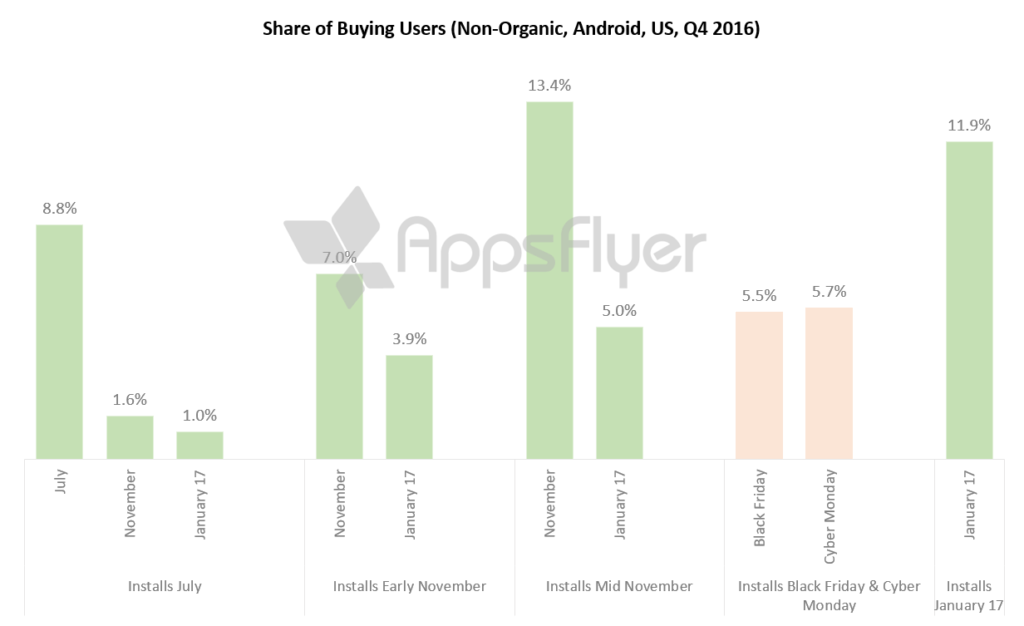
We see that users who installed apps right before Black Friday and Cyber Monday were more likely to purchase something during peak periods (91% more purchases than July). Those who installed apps on Black Friday and Cyber Monday were 42% less likely to make purchases on that day. And those who installed apps in early January show a high likelihood of purchases throughout the month.
The mid-November peak brought in 140% more shoppers than Black Friday and Cyber Monday.
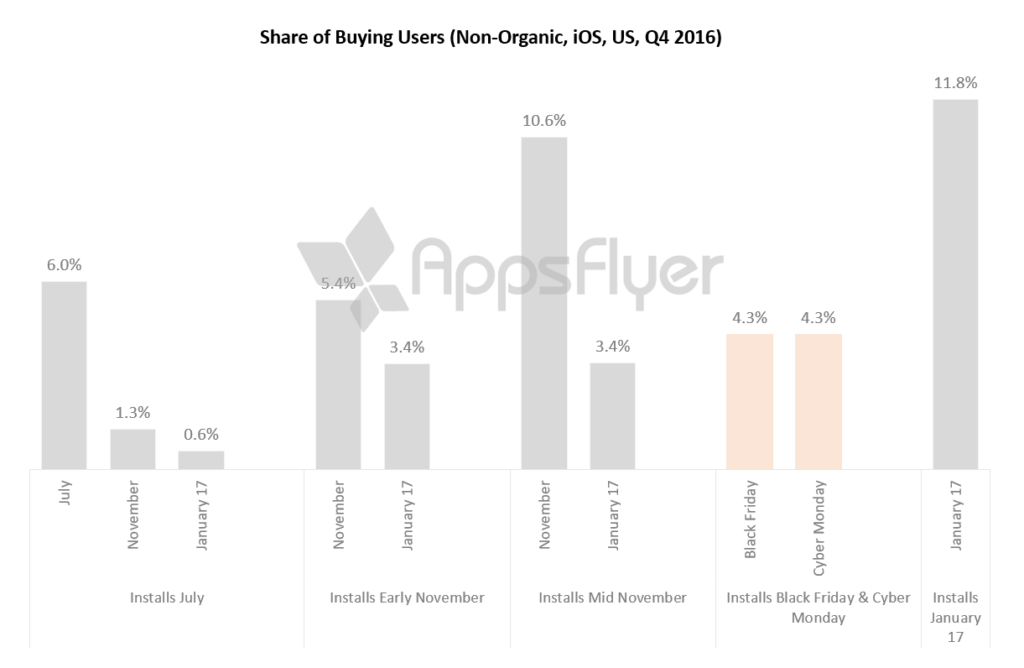
iOS users who installed apps before Black Friday and Cyber Monday were more likely to make purchases during the peak period (77% higher than those who installed apps in July). Those who installed such apps on Black Friday and Cyber Monday were 59% less likely to make purchases. On Android, the peak period brought in 147% more users willing to shop than Black Friday and Cyber Monday.
So what does all this mean for marketers running campaigns during this time?
1. The end of November is a time of frantic shopping. During this time, people buy often and spend a lot. To use the full potential of these days, you must:
- Attract users long before the peak period. The more data you have, the better you can customize user segmentation. After all, this will pay off doubly during re-engagement campaigns (retargeting, push notifications, mailings).
- Attracting users right before sales. You may not have a lot of data to do thorough segmentation, but our data shows that at this time you have a high chance of finding exactly the users who are themselves looking for something to spend money on.
- Attracting users during sales. The result may be lower than in November, but based on our data, it is on average higher than in other times of the year.
2. New Year's sales are not the time to give up. The growth of installs from new phones and ongoing discounts whisper that it is not worth interrupting the work of attracting users or re-engaging them. And this is important, despite the fact that the average purchase price during this period is lower than at the end of November
3. Always keep an eye on the rates. As user acquisition campaigns perform well, their value will also increase. But this is justified, because profits these days are much higher. Most importantly, stay alert and be as nimble as possible to maximize your ROI.
4. Use multiple media sources for flexibility. This will give you room for maneuver, timely optimization of campaigns and allow you to pay less with maximum ROI. By increasing your reach, you increase your chances of finding new qualified users and increasing your conversion rate. Most importantly, make sure your media partners can provide accurate targeting so you don't hurt your conversion rates.
5. Well, enjoy the moment. And in January you will have a well-deserved rest.
Hashtags on Instagram- it's a tool quick search necessary photos. This is analogous to an active link on a website. It is through hashtags that people most often search for the information (content) they need. Why use hashtags:
- To attract attention target subscribers to your account. Under each post, place hashtags related to your occupation, so it will be easier to find you.
- To increase the number of likes. There are several apps, such as InstaTag, which offers lists of popular hashtags grouped by category. So far they only contain English hashtags; I haven’t come across Russian hashtags, but I think that analogues will appear soon. The likelihood of getting new subscribers this way is very small, but the fact that you will get a lot of likes immediately after publishing is unambiguous.
- To search for all your posts, if you have several services and have a separate account for each, you can combine them with a common hashtag, for example, #campaign name. Then, when they click on such a hashtag, users will see a search result with all your services.
- To collect content. For example, if your promotion strategy includes the publication of user-generated content (for example, a photo of a client with your product - #nikerussia or the result of your work - #bridemakeup). For this occasion, come up with your own unique hashtag, forgive your clients to publish it under the photo and choose the best ones to publish in your feed. For your clients, this will be motivation to take great photos; for you, this will be valuable and interesting content, which will increase the loyalty of all your subscribers.
- To conduct competitions, promotions, and sweepstakes. Ask participants in your marketing activities to use your hashtags and encourage participants to do what you have in mind.
What hashtags to use to attract target audience
Check each hashtag for popularity before posting. If a hashtag search gives you more than 7,000-10,000 photos, then it’s better to look for a less popular hashtag. Otherwise, your photo will quickly disappear from visibility and there will be little use.
For example,
Badly:#marketing - you probably won’t find my post in the search results anymore, and even less so tomorrow.
Better:#marketing - if I post with this hashtag every day, I will almost always be visible;
Fine:#marketing move - for now it is enough to publish once every 1-2 weeks. And please note that this hashtag is used more often ordinary people who are interested in the topic of marketing and, most likely, they themselves are in this topic, which means they may be interested in my public. And when they view photos using these hashtags (and most often users use the hashtags they put under their photos) they will notice my post.
How many hashtags to put under a photo?
A large number of hashtags indicates that the account is engaged in attracting subscribers and promotion. For ordinary users- this is not critical, but nevertheless an irritant perceived as advertising.
Therefore the formula is simple:
— 5–7 hashtags for each post, if you want more, divide into groups. for example, the first group of 5 hashtags will work to attract your target audience, the second group will work to attract likes, the third group will work on uniqueness (for example, for me it’s #30daystobepro). Insert each group of hashtags in the comments after the description.
Firstly, because they will become invisible after 3 real comments from your subscribers and will no longer irritate the eyes. And secondly, any group can be deleted at any time, leaving, for example, only a branded hashtag and the feed will be very beautiful and non-advertising.
Hashtags for Instagram are keywords or entire phrases preceded by a "#" sign. Once upon a time this sign was just a grid, but now it’s indispensable assistant users of social networks.
At first glance, hashtags may seem intrusive, useless, and even annoying. But this may seem only to beginners social services. Experienced users know how to use hashtags to make their page popular and viewed.
They allow you to quickly find the photographs you need on a specific topic. By putting tags under your pictures, you can get new followers who will be able to find your pictures online among millions of other photos. So it would be stupid not to use this effective way increase the popularity of your microblog like hashtags. If you want to know how to put hashtags on Instagram correctly, this article will be useful to you.
How to use hashtags on Instagram
Any word preceded by # is automatically recognized by the service as a hashtag. Each hashtag is an active link.
Tips for correct spelling hashtags on Instagram:
- If you want to write not one word, but a phrase or even a whole phrase, do not use spaces, but simply write the words together, for example, #likeforlike.
- You can also create your own unique hashtags by writing whatever you want, for example, #iamhappygirl.
- In order for your photos to be viewed by new people, and your account to gain momentum in popularity, you need to use popular hashtags, and not those invented by you personally.
- For Instagram, tags can be written in both Latin and Cyrillic alphabet. But hashtags in English are much more popular.
- When writing multiple hashtags, separate them with spaces.
Why do you need hashtags on Instagram?
Using popular hashtags, Instagram users search for interesting photos. Hashtags are convenient way navigation. By writing a hashtag correctly, you can reach a large audience and organize information.
On Instagram, hashtags serve not only to determine the theme of the photo you uploaded, but also to make new acquaintances and expand your circle of followers.
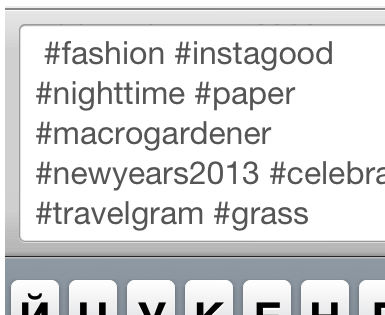 Hashtags are also a way to get likes and comments. How it works: You upload a new photo and add a popular hashtag to it. Any user who searches for pictures using this hashtag will see your photo and, if he likes it, will like it or leave a comment. In order for a hashtag to appear under your photo, you just need to add it to the description of the photo. You can use an unlimited number of hashtags, but don't get too carried away with this feature.
Hashtags are also a way to get likes and comments. How it works: You upload a new photo and add a popular hashtag to it. Any user who searches for pictures using this hashtag will see your photo and, if he likes it, will like it or leave a comment. In order for a hashtag to appear under your photo, you just need to add it to the description of the photo. You can use an unlimited number of hashtags, but don't get too carried away with this feature.
How to find a photo using a hashtag
Any hashtag on Instagram is an active link, clicking on which will take you to the specified publication. 
You can also click on the star in the Instagram menu, and then enter the desired hashtag in the search bar. The program will offer you a whole list of recently uploaded photos with this hashtag.
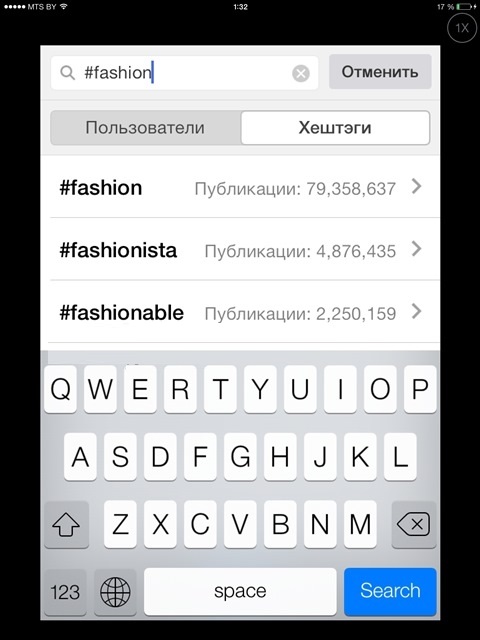
The answer to the question of how to put hashtags on Instagram is very simple, the main thing is to use thematic tags under your photos and a special symbol, the hash mark (#). Let's use an example to look at the immediate order of how you can put hashtags on Instagram, in your publications, and also in comments. Everything is in the photo, instructions.
A hashtag is a tag that helps users of the system, in our case the application and its web version, Instagram, find content, in other words, photos, videos, people, geo tags, places on the map and pictures associated with them. For those who are typing, how to put hashtags on Instagram.
Login to your account, turn on the camera and take a photo, alternatively add an existing photo from a stream or gallery, your mobile device. We choose the latter and add a pre-prepared snapshot directly from the device. This is a girl standing with her back, with a touch touch, we go through the active field [further], we pass the photo editor (there is no page in the screenshot), clicking, further again and we get to last page(publish) before publishing the photo to the application.
By touching the field (add signature), we call the command from the pop-up keyboard. Now in this field you can add a description, for example, my favorite at dawn, and then insert thematic tags. You can do this as follows: before the word, which will later become a hashtag, you need to put special character(#) hashtag, it is he who converts an ordinary word into a hashtag within the system. If the hashtag is already used in the system, then in the form of a drop-down photo you will be shown popular tags and the number of publications using this hashtag.
Note;
- There should be no space after the # hash!
- Two words are written together or you use underscore girl_back.
- Below the publication.
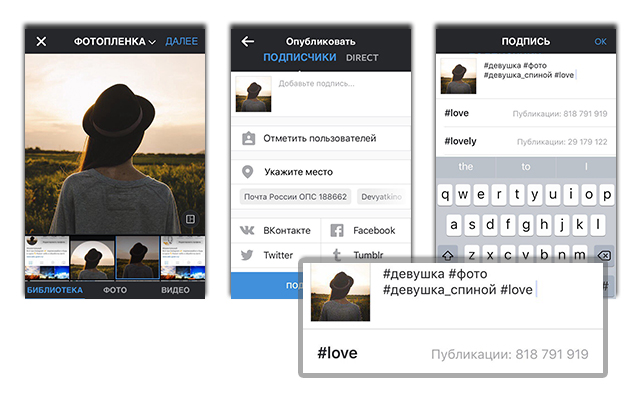
What hashtags to put on Instagram
Using a hashtag, users of the social network Instagram search for photos, videos, places on the map, and thematic accounts. Therefore, what goal you are pursuing depends on what hashtags you should put under your photo. It is recommended to write thematic hashtags - this means that the tag should convey and correspond to the essence of the photo or video. If it is nature, then it is grass, sun, forest, nature, tree and so on, the same with other directions.
In addition to the fact that a hashtag can be added to the description of your photo, after publication of your photo, they can also be written in the comments. This is done for greater visibility of the published content within the application. Simple manipulations, click the icon, add a comment, write the necessary hashtags, that’s it! Hashtags are active tags, something like a link by clicking on which you will be shown recommended hashtags, as well as photos and videos of other users who have used a similar hashtag.

